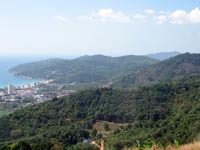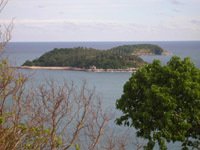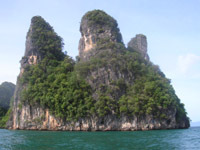Geography of Phuket
 Phuket is on the southwest coast of Thailand. It is 860km south of Bangkok
and 830km north of the equator (7.5 degrees latitude). This puts it on a parallel
with countries such as Ethiopia, Nigeria and Venezuela.
Phuket is on the southwest coast of Thailand. It is 860km south of Bangkok
and 830km north of the equator (7.5 degrees latitude). This puts it on a parallel
with countries such as Ethiopia, Nigeria and Venezuela.
Phuket lies in the Andaman Sea which is part of the Indian Ocean. Phuket is the biggest island in Thailand and the only island big enough to be a province in its own right. The island is 49km long and 21km wide comprising a total area of 570 sq km. including 70 sq km from 39 smaller islands around Phuket. Phuket is separated from the mainland by a narrow sea channel and connected by the 600-meter Sarasin Bridge.
The geography of Phuket is varied. The island is mostly granite and sedimentary rock. There are many hills, some rising above 500 meters. The main hill ranges run down the west coast of the island but there are hills everywhere. The flatlands are mostly urbanised or used for agriculture such as rubber and coconuts. There are also mangroves and tropical rainforest in Khao Phra Thaew National Park.
The best beaches are along the west coast of the island. They have been forged by the waves that beat into this side of the island through the rainy season creating spectacular beaches in bays split by rocky headlands.
The east coast of the island has smaller beaches that tend to be a little muddy. This is because the seabed on the sheltered easy coast still has a lot of sludge and mud stirred up from the old tin-mining days when the seabed was extensively dredged. Much of the east coast is covered by mangrove forest.
There are two types of island around Phuket. There are the granite islands that lie to the west and close to the south and east coasts. They tend to be forested low lying islands with beaches such as Koh Racha Yai and Koh Hee (Coral Island). Then there are the limestone islands to the northeast, and further out to the east and south. These islands tend to rise vertically from the sea producing dramatic scenery such as the Phi Phi islands and Phang Nga Bay. The limestone platform that produces these islands runs east of Phuket from Phang Nga province, through Krabi province and into Trang producing spectacular scenery all along this stretch of coastline.
Phuket is basically a stable geographic location. Until the 2004 tsunami, it was not considered an area that ever suffered from major natural disasters. The rainy season always sees a few big storms but nothing that would be categorised as a typhoon. The rainy season does occasionally cause localised flooding. The rainy season has also caused a few landslides and a few lives have been lost in these. However the landslides have generally happened at building sites where the trees and bushes that supports the steep sided hills have been stripped away.
There is no volcanic activity in Phuket.
The massive earthquake that caused the 2004 tsunami was just about felt in
Phuket but did not cause any damage. However there is a minor fault line
that does run under Phuket and in April 2012 Phuket experienced the very
unusual event of an earthquake of its own. It was only 4.4 on the richter
scale but that was enough to give everyone a quick shake. No serious damage
was done and this is the only earthquake to directly hit Phuket in modern
history. It is a minor fault line and is not likely to ever cause a major
earthquake.


